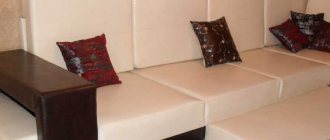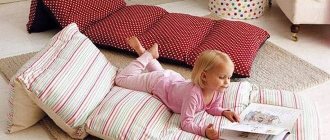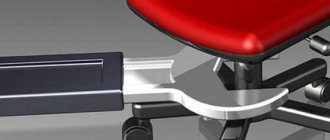Any furniture that is in your apartment gets old, becomes unusable, the upholstery is torn, stains and scuffs appear. It is impossible to sit on it; it spoils the appearance of the interior. There comes a time when you have to throw it in a landfill or take it to the country.
Old chairs are often simply created for restoration and new life.
If the chair has retained its strength, it has a strong base, reupholstering the furniture is a great chance to return the piece of furniture to its former beauty. It can last for many more years.
There's nothing better than using worn-out furniture for a makeover.
Choosing the right fabric
To choose the right upholstery material, you need to take into account some points: the density of the upholstery - the fabric must be strong and retain its shape; no problems with washing; If necessary, it was easy to clean with soapy water or a brush.
Typically, chair upholstery is done with fabrics that can hold their shape.
Let's list the materials most suitable for the job: leather, but it is easily susceptible to scratches and other defects; jacquard – strong, wear-resistant; flock, velvet - good quality, does not fade; chenille is a common material, compacted, practical; artificial leather – does not wear out for a long time; tapestry - easy to wash.
The best option is jacquard, tapestry, flock, chenille.
Suitable type of upholstery fabric for the chair
The type of upholstery fabric depends on where the chair is placed and for what purpose it is used.
If chairs are in the kitchen, or if you need to cover kitchen stools, then most likely it is not advisable to use natural materials for upholstery, especially if there are children or pets in the house. All kitchen surfaces and objects are most susceptible to severe contamination, which neither wet nor dry cleaning can cope with.
Some products can irrevocably damage upholstery, just like the art of growing family members, not to mention dog teeth and cat claws.
The following requirements apply to fabrics for upholstery of kitchen chairs and stools:
- Waterproof;
- Resistance to mechanical stress;
- Inability to crumple;
- Strength;
- Fire safety;
- Easy to care for.
Synthetic materials have all the above characteristics. It can be:
- Leatherette, for example Arpatek, is the inexpensive “king” of furniture upholstery;
- Genuine Leather;
- Eco-leather.
Synthetic materials have all the above characteristics.
The upholstery of furniture chairs for living rooms, dining rooms and offices should have slightly different characteristics, including:
- Low or absent peelability (ability to form pellets);
- External attractiveness;
- Compatibility in style with other elements of the interior of the room - curtains, carpets, sofas;
- Wrinkle resistance;
- High wear resistance;
- Resistance to fading in the sun;
- Fire resistance;
- Easy to clean.
Materials with the following properties:
- Chenille - spirally twisted fibers with woven fibers;
- Jacquard is a dense combined relief material with a pattern;
- Scotchgard is an upholstery fabric impregnated with a water- and grease-resistant composition;
- Flock - or "Anti-claw" - upholstery that can withstand the claws and teeth of pets;
- Velor is a fleecy dense material;
- Alcantara, microfiber and other high-tech synthetic upholstery materials that provide increased wear resistance.
Chenille - spirally twisted fibers with woven fibers
Interesting! Upholstery fabrics are often treated with special Teflon compounds to provide additional strength and water resistance. Not only will dirt and dust not stick to a chair upholstered with such material, it will also repel grease and water.
Upholstery fabrics are often treated with special Teflon compounds.
It is no longer necessary to choose between durable synthetics and safe natural fabric. The modern textile industry offers a myriad of types of upholstery materials that combine all the characteristics required for furniture, from strength and aesthetic appearance to hypoallergenicity and resistance to stains.
Required Tools
Having decided on the upholstery fabric for the chair, we prepare the tools that we will need: a sewing machine, an anti-stapler for removing old staples, thick cardboard, a brush, PVA glue, a set of screwdrivers, pliers, a furniture stapler, staples or a hammer and nails, a centimeter or tape measure, scissors , chalk, ruler, pencil.
Tools for upholstering chairs.
What materials are needed? Firstly, the fabric. It is better if it is jacquard, tapestry or flock - they are good quality, strong enough, and do not wear out for a long time. Before making a purchase, we take measurements and add 15-20 cm for hem and upholstery height. Secondly, filler. The most acceptable option is sheet foam rubber with a thickness of 4-5 cm and a density of 30 to 50 kg/m3. Bulk materials are completely unsuitable. Thirdly, padding polyester. It is used as a stabilizer, placed between fabric and foam rubber. The material glides along it easily, stretches in one moment and without wrinkles.
To determine the size of the cut to buy, measure the seat and add 15–20 cm to allowances on each side.
Stages of reupholstery
Reupholstering chairs with your own hands is carried out in stages. First you need to remove the used upholstery, then dismantle the frame and attach new fabric. The backrest is renewed at the end of the process.
Removing old upholstery and disassembling the frame
You need to start by removing the upholstery. For this purpose, a furniture anti-stapler is used. The master needs:
- Connect the edge of the anti-stapler to the center of the staple, lift the tool while pressing on the frame.
- One of the ends should come out, after which you need to pull out the bracket using pliers.
- Repeat the same with all staples.
- Remove old fabric and seat.
- Repeat the entire process with the upholstery on the back.
It is highly undesirable to tear the upholstery on a chair, as this can damage the frame of the structure. Dismantling should be done carefully, starting from the edges, moving towards the center.
The next step is to disassemble the frame. For this you will need a mallet. Tap the frame with the tool so that the product is divided into the back, seat and legs. If no fungus or mold is found on the parts, as well as chips or scratches, they are in good condition. But rotten parts will have to be replaced. After this, you need to check the remaining connections and disassemble the loose parts. All elements must be cleaned, reassembled and sealed.
Creating a soft substrate
The dimensions of the backing must exactly match the dimensions of the seat. Here you should also provide seam allowances ranging from one and a half to two centimeters around the perimeter. Excess fabric can be trimmed. A soft substrate at home is made as follows:
- Prepare a pattern on paper or directly on the material. Depending on the seat, the shape of the backing will be round or square.
- Cut the product using special tailor's scissors according to the prepared pattern.
- Apply a thin layer of glue to the seat, place the backing and wait 15 minutes.
- To achieve optimal results, add a thin layer of synthetic padding on top. The good thing about using natural materials (for example, horsehair or dried grass) is that they will last a long time and will not harbor dust mites.
If necessary, trim off excess soft backing.
Fastening the upholstery
To properly replace the chair upholstery, you will need the thickest fabric, for example, calico. When working, you should adhere to the principle of the drum: pull as tightly as possible and equally on all sides. As a result, not a single fold should form. The hammer should not be used at full strength. The process of attaching the upholstery consists of the following steps:
- Attach the upholstery to the front and back of the furniture using a stapler, after making cuts where the backrest connects to the seat.
- Stretch and attach the material on the right and left.
- Install the brackets correctly (with an even load on one side and the other). If somewhere the fabric is tightened more, take a thin screwdriver, pull out the staple, tighten the fabric and secure it again with a stapler.
- Repeat step #3 front and back.
- Trim excess fabric.
- Take the finishing fabric, iron it, and attach it to the seat using a similar principle.
Types of chairs for schoolchildren, the best brands, selection criteria
Working with wallpaper nails will require more time. They are short, so you won't be able to tear the foam backing. In addition, for fastening you will need a tape made of thick fabric.
Removing old upholstery
Furniture restoration begins with dismantling. How to properly remove old fabric? First of all, we unscrew the seat - we use a screwdriver to hook up the fasteners, remove the nails, unscrew the screws, and remove the metal pads. Use an anti-stapler or a flat-head screwdriver to remove the old staples.
We put the fasteners in a container, it may come in handy.
Then we inspect the base of the chair, if it is loose, it needs to be strengthened - fill the cracks with sealant or PVA glue, you can cover them with putty, tighten the weak points. We remove the old upholstery and carefully remove the foam rubber. If you didn't throw away the fabric you removed, use it as a pattern.
Remove the remaining foam and glue from the seat frame.
Features of a computer chair
The main feature of the chair is practicality, comfort and absence of harm to health.
Before purchasing, pay attention to the material and structure
- Choose a durable frame, which can be metal or polyamide.
- Stable and practical base. It is a 5-ray base with rotating rollers along its axis.
- Convenience should be complemented by the possibility of smooth swinging, rotation along the axis, height adjustment and a powerful gas cartridge.
- The backrest is of high quality when it follows the curve of the back in the lumbar region. A bonus will be the presence of a fixed tilt level with a backrest tilt regulator depending on the weight of the seated person.
- The back should not be very low. The best option: either at shoulder level or above the head.
- Don't forget about hand comfort, the armrests provide it.
- The color scheme and fabric or leather depend on the personal preferences of the person sitting.
A computer chair must be selected taking into account certain criteria.
All these factors are important when choosing an item not only for your home, but also for your office. Comfort and a healthy back should be in any case.
The reupholstering process: step-by-step instructions
How to reupholster a chair. First of all, we attach the foam rubber to the plywood using PVA glue. We reface the seat as soon as the glue has dried.
Using the template, cut out a soft pad from foam rubber.
Apply foam adhesive to the underside of the pad and to the surface of the wood seat.
Then we place the material face down, place the seat on it, so that the foam rubber lies on the upholstery, put padding polyester between the foam rubber and the fabric as a layer. Then we fold the material onto the base, stretch it carefully so that there are no folds, and attach it with a furniture stapler.
Cut a piece of fabric to the desired size. It’s not scary if it turns out to be a little more than necessary, the main thing is that it’s not less.
Lay the fabric face down on a flat surface and place the foam seat on top.
Use a stapler to secure the edges of the fabric.
Carry out the work without exceeding a step of 2 cm. Cut off the excess fabric. We fix the finished seat onto the frame - first we fasten the plates, then the screws.
Turn the draped seat over and evaluate the result.
Place the seat in place and secure it with screws.
Selection of upholstery material and filling
Before reupholstering a chair, you will have to study some information about what exactly to use when restoring a chair or armchair. Please note that you can use not only the materials listed in this paragraph. We have described the most common, synthetic, inexpensive, with acceptable characteristics. If desired or necessary, you can use natural analogues - copra in mats or rolls, batting, dried sea grass, horsehair, burlap and other materials that are exotic today and once traditional.
Most common materials
What materials are needed to reupholster a chair?
When restoring a chair or armchair, foam rubber or polyurethane foam (PPU) is used for the soft part. We are talking about foamed polyurethane foam, not sheet. There is also furniture latex. It and polyurethane foam differ from foam rubber to the touch. They are more like rubber (latex is generally like rubber); when stretched/compressed, they tend to return to their previous shape.
To be soft enough, the density of these materials should be 30-35 kg/m³. Foam rubber and polyurethane foam are sold in large sheets - the minimum size is 1*2 meters. So that's enough for more than one chair. Latex is usually available in some standard sizes, but is most often made to order.
Different thickness, density, rigidity, different manufacturing technologies
What is better to use for upholstering chairs - foam rubber, latex or polyurethane foam (PPU)? If we talk about quality and durability, then latex or polyurethane foam is better. They will last up to ten years or more without signs of wear, they absorb better and wear out less. The best of this pair is latex, but it is much more expensive than even polyurethane foam, not to mention foam rubber. Therefore, if you are on a limited budget, choose foam rubber. If durability is important - polyurethane foam or latex.
Now on the thickness of these materials. For the back, a thickness of 3-5 cm of foam rubber/PPU/latex is sufficient, depending on the degree of desired softness/hardness, but for the seat it is better to use materials with a thickness of 7-8 cm or more. If the base is solid - made of plywood, without springs or tapes - a thickness of 10 cm is needed. Otherwise the base will be felt.
The three most common materials are foam rubber, polyurethane foam and latex.
A padding polyester is laid on top of the foam rubber. Its thickness is small - 1 cm in a free state or so. It’s easier to navigate by density: 150-200 g/m². This layer is needed so that the foam/PPU/latex rubs less. This way, restored upholstered furniture will last longer.
If you want the chair or armchair you have reupholstered to last longer, another layer of spunbond is stretched over the padding polyester - this is a non-woven material made from a polymer melt using a spunbond method. Spunbond costs very little, but significantly extends the life of the seat. This layer is found in expensive furniture and increases durability (foam rubber/sintepon does not rub) and comfort of use (upholstery fabric does not fidget). A possible disadvantage is the accumulation of static electricity. But this is observed only when natural wool or silk is used in upholstery.
How to cut and fasten
The foam is cut to fit the size of the seat. The easiest way is to make a template at the initial stage: attach a sheet of cardboard to the seat, trace it and cut it out. This template will be needed more than once, so it’s better to make it.
It’s better to make a template right away, especially if you will be dragging several identical chairs
We cut out foam rubber and padding polyester strictly according to the template. In some cases, it is worth making it wider and longer by 3-5 mm so as not to feel the edges of the base. The cut foam rubber is glued to the base using furniture glue. There is a special glue in a can for foam rubber. It is more convenient to use, but it is not easy to find everywhere.
The padding polyester is laid on top - one side is more “rough”, so we place it on the foam rubber/PPU/latex, level it and smooth it with our hands. After this, it is problematic to separate the laid layers (you can try). If this method does not seem reliable enough to you, you can glue the connection by applying a mesh of suitable universal glue or the same glue for foam rubber.
Latex is usually made to order, so the edges are rounded for greater convenience.
One point: if the base of the chair is not rigid - springs, tapes, a snake - the glue you should use is not the one that forms a hard crust after drying, but the one that remains elastic.
If you decide to also use spunbond, it must be cut out with a margin, attached with staples to the base, evenly straightened and stretched. You should not pull too hard - the material is non-woven and is easily damaged. It just needs to lie without folds. Carefully trim the excess to the level of the chair/chair frame.
How to restore a chair back
Repairing the back of a chair starts with the frame. We disconnect the parts, remove the old coating, and sand it. If there are cracks, fill them with glue using a syringe, you can apply putty. If desired, repaint the chair in a different color or simply varnish it. When all the parts have dried well, we connect them.
If there is upholstery on the back, the material and filling must be replaced.
First, we attach the back part of the back with a stapler, stretching the material from the middle to the corners. Then we glue foam rubber in front and attach fabric with a sewn-in edging. It covers the staples so that they are not visible. By restoring old furniture, you will not only extend its service life.
You will have an original piece of furniture in your home that no one else has.
Nuances of backrest restoration
To change the back upholstery, it should be dismantled, putty or seal the existing cracks, and chips should be cleaned. After this, you need to install the backing, cover it with fabric, apply paint and varnish. The process then consists of the following steps:
- Cut the rough fabric according to the pattern with a margin of up to 3 cm to make pulling more convenient. Pet her.
- Pull the upholstery over the backrest on one side.
- Secure the fabric with a stapler, moving from the center to the ends.
- Glue the soft backing to the front.
- Fasten the fabric tightly to the edges.
- Repeat the same with the finishing cloth.
Designing and assembling a stool with your own hands, decor options
The excess should be carefully trimmed and the edges should be coated with glue. Staples or nails will not be visible if the chair is decorated with braid, which should be secured to the edges. It is convenient to do this by attaching them with pins, which can be removed about two hours after gluing. Then the product remains to be painted (acrylic paint is optimal, since the water-based composition will quickly wear off) and varnished. A chair with a back should look neat both in front and behind, and on the sides. You need to remember about the underside; it should also be stretched with fabric.
How to sew a new chair cover
Chair covers are becoming popular again. This is not only beautiful, but also protects the furniture from various contaminants, in particular from your beloved pets, and can be quickly removed and washed. It’s better to sew several covers and change them according to your mood.
Any housewife can sew a cover for a chair.
To work, you will need about two meters of fabric, thread and needle, scissors, a tape measure, pins, a sewing machine, and chalk. First we make a pattern, you can use an old cover, do not forget the seam and hem allowances.
The most important thing is to take into account the thickness of the back and legs, their curves and how much the fabric will shrink after washing.
To make the product fit snugly, make fasteners in the form of ties, buttons or zippers. The seat and back can be cut and sewn separately or as a whole fabric.
Sew according to your individual design, being patient and careful.
Features of re-tensioning the base with belts or a snake spring
To restore old chairs on canvas, you will need synthetic rubberized belts of approximately the same width. They are fixed in the center of the bar towards the frame. The new strip is secured with staples, rotated and fixed again. Then it is secured and tensioned on the opposite side. A soft substrate is placed on top. The tools you will need are a steelyard and a furniture stapler with staples.
You need to pull with a force of 1 kg on the seat, 8 kg on the back. When one side of the belt is already secured, a steelyard is hooked to the other end and pulled until the desired number appears. The desired length is marked with a marker.
To replace the snake spring, it must be fixed to the frame using special fasteners, and they, in turn, must be mounted using brackets on long legs. When positioned correctly, this part has a slightly curved shape. If you want the upholstery to last longer, place a fabric layer between the twisted wire and the pillow. This is done so that the foam rubber does not fray over time.
If the reupholstery of the chair is successful, you can try restoring other, larger upholstered furniture: an armchair, a sofa, a kitchen corner. The work is carried out according to the same principle, only the dimensions and shape of the product change. Restoring old broken things will help you save on buying new ones, and will also become a fun hobby for people who love to make things.
Chairs in the interior of your home – 50 photo ideas:
How to choose materials?
Having assessed the scope of work, you can proceed to compiling a list of materials. Upholstery replacement typically requires the use of the following materials.
Upholstery fabric
The choice of upholstery is entirely a matter of the taste of the master and the features of the interior. But there are nuances here: not every fabric is suitable for upholstering a chair at home.
Therefore, you need to follow several recommendations:
The aesthetic appearance of the future cover should be combined with practicality. Options with a strong odor and fading should be avoided. Probably, low-quality, toxic dye was used in production. A thick fabric with a pile will help a beginner hide upholstery flaws.
At the same time, when cutting out parts, it is important to take into account the direction of the pile. If you forget about this feature, the color of the parts in the final product may differ.
To save on fabric consumption, you should prefer a smooth material with a small abstract pattern. This texture and texture allows you to place the patterns sparingly, in any direction. If the highlight of your design should be a pattern or large ornament, then get ready to buy more fabric
In this case, when cutting, the direction of the lines is important. The mismatched pattern on the seats and back stands out and looks sloppy
For example, if the red stripe abruptly turns into blue, or the details of the ornament are shifted relative to each other.
- When choosing decorative upholstery, consider the purpose of the chair. For example, for kitchen chairs you should choose a material that is durable and easy to clean.
- Leatherette upholstery will add solidity to the furniture, but it will not be much more durable than other types of fabric.
These tips do not imply limited choice at all.
Types of upholstery fabrics can be varied:
Filler
For upholstering upholstered chairs at home, the choice of filler is not so wide: padding polyester or foam rubber
Having settled on padding polyester, pay attention to its color and smell. A shade different from white, as well as the presence of a pungent odor, indicate the use of second-class or toxic raw materials in production.
Check the structure of the material and its strength. A fabric of uneven thickness and density that can be easily torn by hand is definitely not suitable. Suitable foam rubber can be easily distinguished by its structure: the smaller the bubbles, the higher the density and quality. In order not to be deceived by the seller, make sure that when pressed the sample does not make a cracking sound (this is the artificially sealed cells bursting).
- If the chair is spring, you may need jute tape. It can replace springs that have become unusable.
- Elements for decoration: ribbons, lace, cords, buttons and others.
- Cardboard or thick paper for the pattern.
- Primer, paint, varnish or stain for the frame.
- Plywood sheet.
- PVA glue.











